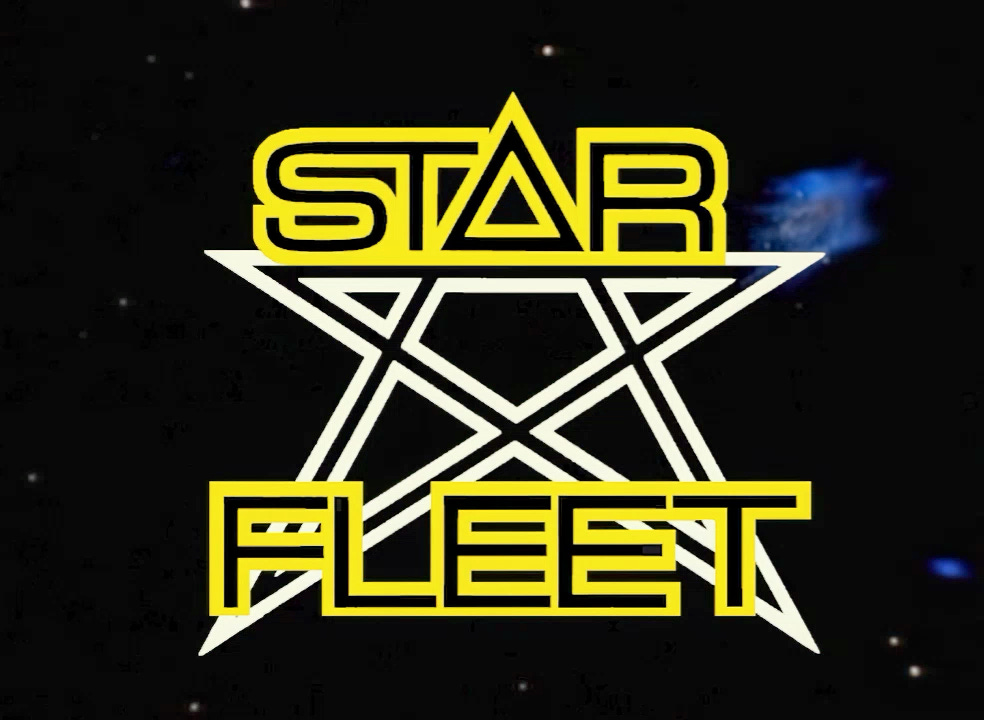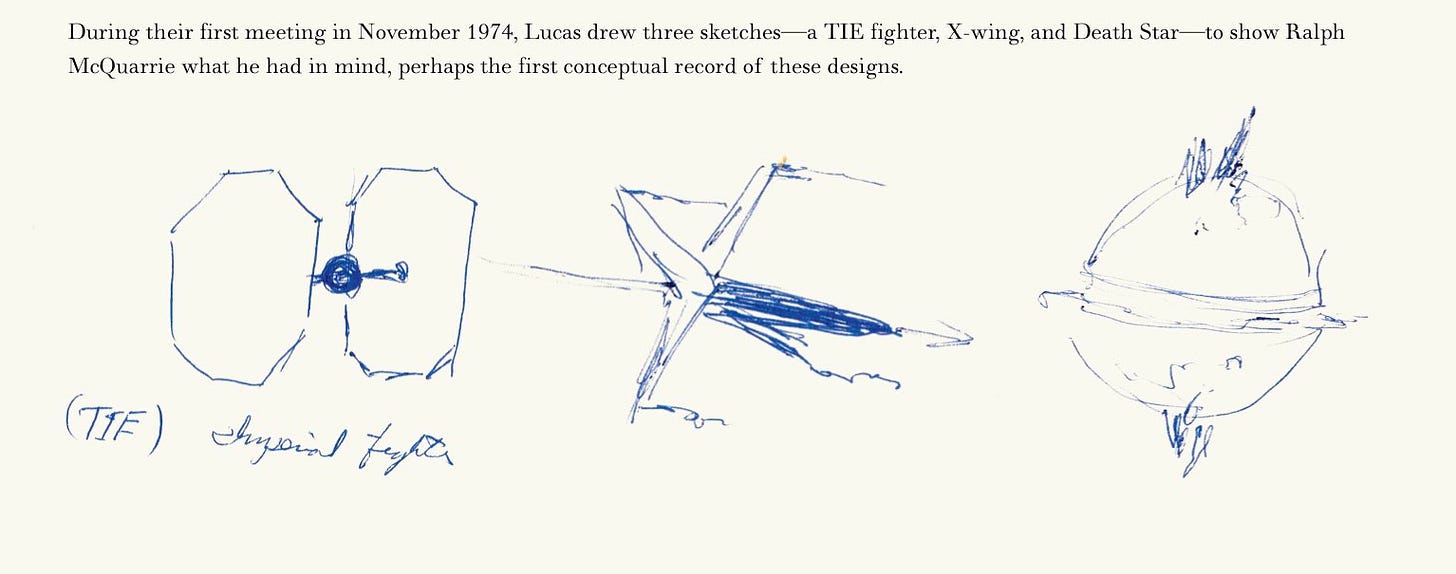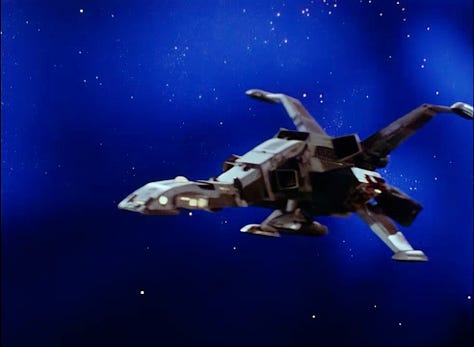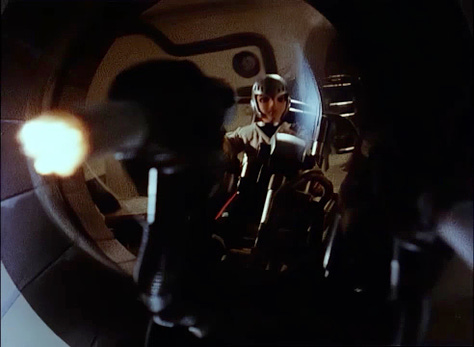One of my passions is shining a light on old, forgotten media that's been historically underrated. Especially media realized through the technique of puppetry. I started a Substack to chronicle my rewatch of one of my favorite examples of this. Star Fleet, an English redub of Japanese puppet show X Bomber. Generally, I prefer foreign films to be subbed not dubbed, but in the case of Star Fleet I find the whole thing so charming that I really don't care about that tradition. It's one that had a huge impact on me. The season long story arc was advanced for Saturday morning TV of the time and laid the ground work for my adult interest in puppetry and cinema. Here's my inaugural post:
https://starfleetxbomber.substack.com/p/star-fleet-da-dee-dah-dah-star-fleet
The year is 1982. The date is the 23rd of October.
You bounce out of bed and tumble down the stairs. Grabbing a bowl of your favourite cereal, or the closest off brand approximation, you strap yourself in front of the TV and get ready for a brand new series to begin.
Thanks for reading X Blogger! Subscribe for free to receive new posts and support my work.
✓
Look-In, a junior version of the TV Times, featured this new show on the cover. Actually, “new” wasn’t quite accurate as the programme was an import from Japan and had been completed way back in 1980, but we’ll delve into the full origin story in future articles. For now, let’s have a watch of…
From the word go, you know you will probably like this if you were already a fan of sci-fi or outer space. It begins with a starry, spacey background and the mysterious words: “A LEAH INTERNATIONAL JIN PRODUCTION.” What’s a Jin Production, you might ask? Is that like Jin and tonic? But there isn’t much time to dwell on it because a five point star sweeps in at the viewer from the depths of space and in flashes of white, red, and yellow it transforms into the Star Fleet logo.
Much has been said of this title. The Japanese version had the slightly more original moniker of X Bomber, which makes a bit more sense in the context of the show. There’s several episodes where the entire point of the plot is the absence of a Star Fleet, but I digress. Star Trek fans like to snidely cast aspersions on the title as a flagrant ripoff of the imaginary organisation that launched the USS Enterprise but I don’t really think this is the case. In the heady days before Wikipedia, unless you were a Trekkie, you might not know about Starfleet and think the term was generic.
The very next shot reveals an X shaped spacecraft. We’d know it was X Bomber if the show was called X Bomber, but it isn’t in the English dub. Immediately, my mind flashes to the X wing fighters of Star Wars fame.
George Lucas doodles that would have also influenced designers Colin Cantwell and Joe Johnston
WTF?
Next up we have a barrage of puppets. Yes, puppets. Today, in a world where even local TV and YouTube videos are starting to look slickly produced, puppets are often seen as a novelty or a quirky oddity. Not so in 1982. Jim Henson’s The Dark Crystal was about to hit UK cinemas the following year and Thunderbirds had finished a run of Saturday morning repeats that February. The last Star Wars movie had featured an advanced muppet character named Yoda. At the time, it was still one of the most high tech forms of animation around.These particular puppets wear blue military styled uniforms and stand ramrod straight in what looks like an office or a control room. The stylishly wood-paneled wall features a bronze eagle insignia guarding the planet Earth (with Japan in the center but obscured by text) and the letters EDF for Earth Defense Forces.
This guy is obviously the boss. More on him later.
What the? Is that puppet making an obscene gesture? We get a glimpse of some of the high tech accoutrement here!
These shots of EDF are odd choices in hindsight. Not only for the relative lack of importance, but for their relative lack of excitement. When I was a boy watching the show, the white haired General’s stiff entrance and the awkward saluting movements of his underlings were the source of much general hilarity. Fortunately, the excitement is about to be kicked up a notch.Heroes! Hooray! Unlike the EDF characters, these guys enter dramatically in Thunderbirds style mechanical contrivances. All I ever asked for was this style of launch sequence for my daily commute.
The first guy is clad in a helmet so you know he’s serious. He’s also got a spiffy Luke Skywalker tunic and some gear we don’t have time to look in detail at right now. The puppets are vaguely Asian, mostly due to their anime/manga eye designs, but ethnically/racially ambiguous enough that I wouldn’t be surprised to find that viewers at the time had this guy down as Caucasian.
The second guy is definitely not Caucasian. With his enormous afro and camouflage gear, he looks like he could have fallen out of a “blaxploitation” flick. If such films were made with puppets, that is. This was the dawn of a new era in racial representation. The iconic Mr T would soon be starring in The A-Team and was already famous for his appearance in Rocky III by the time UK audiences saw Star Fleet. This puppet very much fits in the same archetype. Tough, no nonsense, and good as gold.
Third, we have a rotund, ginger-haired pilot who seems like he could have stumbled in from a Ralph Bakshi movie. It’s hard to imagine Thunderbirds coming up with a character this broad, although there is the infamous El Hudat from Stingray, himself a rework of the villainous Masterspy from Supercar.
Not exactly ginger, are they?
This yellow robot is a lifelong obsession of mine. His flashing red light and yellow colour are still an influence to this day. More later, for now he’s just a nice cover for the drum fill.
Takeoff!
Next we’re treated to a montage of X Bomber taking off in all it’s glory. First, we see it rising from a cloud of smoke, with it’s engines glowing. Then we see it emerge from a crater, under lit by launch lights and looking like a phoenix rising from the ashes. It calls to mind the baddie base of Bond film You Only Live Twice. Next we’re treated to a shot of X Bomber turning to port, to reveal some red vehicle attached to the side (wonder what that could be) and a nice long tracking shot of the whole space cruiser. Clearly, this model was big and they want to show it off.
Although the X Wing was the first image, these additional shots reveal something more in the vein of a Millennium Falcon. It’s bigger than a fighter, but not so big as to be a Star Destroyer or Death Star. So a hybrid of the two most popular ships from the world’s biggest sci-fi franchise? Nice!
Our first glimpse of a guy with a pipe and a widow’s peak. Although it wasn’t obvious on older VHS transfers and low res internet videos, this is a great shot with a matte painting of the Earth and a moonbase control tower in the background and some lovely puppet scale furniture in the fore. The character’s smoking is probably meant to be a fatherly aspect. His brown jacket has a warm tone that reminds me of some ancient furniture I used to own. That and the music is telling me this is a kind of home base for our heroes, who we see out of focus behind that damn yellow robot again…
Yay, more puppet salutes! Mercifully, these are a bit better puppeteered and less likely to be mistaken for cocking a snook
We are informed by these guys, in their own English voices, that they are (L to R) space pilot Hagen, space pilot John Lee, and Barry Hercules.
BARRY HERCULES?! Well, just wait till you find out what his name was in the Japanese original.
Space pilot Hagen, AKA Helmet Guy, isn’t given a first name in the opening credits. Is space pilot a job title or rank? It’s not clear, and throughout the series the writers (The Master and The Equalizer creator Michael Sloan, with some possible contributions from producer Louis Elman and voice actor Peter Marinker) are not consistent about terminology. Likely, this is because the script/transcription of the Japanese original was translated literally with no attempt to separate “space pilot” from “star pilot” or “laser torpedo” from “laser blast".”
A girl!
Next we’re introduced to the first female character, by way of a dramatic zoom in. This puppet is among the most successful in the series in this author’s humble opinion, and displays a lot of the craftsmanship and skill that went into making this show. Japan is a historical home for some of the best doll making in the world, and it shows in this character.
Hello, we're the baddies.
Next, we’re treated to a rapid montage of the villains/villainous from Star Fleet. There’s a catfish faced spaceship that looks like nothing I’ve ever seen before or since and a red-headed warrior princess character with an inexplicable piece of headgear. Plus, a reptilian sidekick and a beam weapon that looks like film scratches but was probably cel animation. Wow! Then, another barrage of action from the early episodes.
STARFIGHTER GO BOOM! X BOMBER GO WOOSH! BUG FIGHTERS! ZAP! ZAP! BOOM!
Time to address the elephant in the room– English audiences were no doubt thinking of the sci-fi puppet shows produced by Gerry and Sylvia Anderson while they were watching this. Supercar, Fireball XL5, Stingray, Thunderbirds, and Captain Scarlet to name a few. And why wouldn’t you? After all, puppets and sci-fi wasn’t an everyday mix. But while these shows (known as Supermarionation) were an influence on X Bomber, they weren’t the only one. I think this blog will go a long way towards proving that there was much more to Star Fleet than Supermarionation.
That being said, this final sequence of images is the most Gerry Anderson influenced bit of the whole of the opening titles. It’s action, action, action! Explosions! Lots of cool stuff happening divorced from context, as in the famous title sequences of Stingray and Thunderbirds.
But having dusted our feet lightly with Thunderbirds level action, we’re soon back into uncharted realms of sci-fi romanticism. Instead of another explosion we get a long, slow, zoom out revealing a giant red robot spreading it’s arms across an astral landscape.
Wow. This was quite different in 1982 and quite different even for today. Was this robot a character? A vehicle? Something in between? It’s a striking visual among striking visuals, what with X Bomber and the insectoid vehicles. Breathlessly, we fade to black to begin the episode proper.
The opening title sequence was one of the most important parts of a television series in 1982. If you were checking out something new, it was essentially a trailer to try and get you hooked for the full 20 to 30 minutes. If you knew the show, it was your last chance to grab snacks before the new action began. It could also be a siren song echoing through the whole house summoning kids of all ages to come and join in the fun. Plus, they would be watched more times than any other clips and would later stand as the calling card of the show in the era of home video and later online video sharing. So these first 70 seconds were some of the most essential in the whole show. They had to be high octane, they had to get your attention, and they had to be good.
Does Star Fleet succeed here? Yes and no. For the most part, we get a fast glimpse of our heroes, main vehicles, and the essential elements of the show, but there is no hint of the long term story arc Star Fleet was to build across it’s run. Also, as noted above, there’s a few shots that simply seem like odd choices and the title itself is a bit questionable. The five pointed star doesn’t appear in the series and doesn’t seem to symbolize anything. There are more than five crew aboard X Bomber, unless you don’t count Lamia and Kirara. It does, however, look spiffy on merch and no doubt has attracted some attention from the “Star fill-in-the-blank” audience over the years.
A Star Fleet T-Shirt sold in Look In Junior TV Times for just £2.99. This image comes from sfxb.co.uk
The biggest success of the opening titles is the theme, composed by songwriter Paul Bliss. This was his first attempt at a soundtrack, according to the CD booklet, and this makes the success even more staggering. Star Fleet’s opening theme is a catchy motif that recurs throughout the episodes at heroic moments. The synth sound has aged nicely, unlike some other early experiments of the time period, and is a nice way to make a soundtrack without having to hire an orchestra. No doubt a boon to cash-strapped producers! To modern ears, the motif has a pleasantly retro style with a lyrical quality. You can almost hear a Stingray style vocal choir chiming in with “Star Fleet, Da-Dee-Dah Dah, Star Fleet!” along with the melody.
Overall, a strong opening to what was about to be a very strong episode…
Watch the opening titles yourself here!
1982 was a helluva year for kids who love sci-fi. Documentary producer and filmmaker Mark A. Altman called it the “greatest geek year ever.” Blade Runner, The Thing, Star Trek II, and ET were all coming out, most delayed behind their US opening dates. On UK TV, the year had begun with the changing of the guard in Doctor Who when long time star Tom Baker would step down to be replaced by a vet from All Creatures Great and Small, Peter Davison.
Star Trek crew have been notoriously inconsistent with the spelling of “Star Fleet” often styling it “Starfleet” although the latter definitely seems like the most dominant spelling in Trekdom. In the early episodes of TOS, the organisation had several other names before Starfleet was landed on in the episode “Court Martial.” If any fans know how the writers landed on the term, let me know! I have, so far, been unsuccessful in tracking down pre-Trek occurrences of “Star Fleet.”
Since I’ve referenced the Stingray opening so many times, I feel it’s prudent to link to it here:







![[video-to-gif output image] [video-to-gif output image]](https://substackcdn.com/image/fetch/w_1456,c_limit,f_auto,q_auto:good,fl_lossy/https%3A%2F%2Fsubstack-post-media.s3.amazonaws.com%2Fpublic%2Fimages%2F88992628-62d6-43ce-992e-1e6cffcebd02_600x439.gif)











![[video-to-gif output image] [video-to-gif output image]](https://substackcdn.com/image/fetch/w_1456,c_limit,f_auto,q_auto:good,fl_lossy/https%3A%2F%2Fsubstack-post-media.s3.amazonaws.com%2Fpublic%2Fimages%2F08e30f7d-c57c-4e5f-a9b6-567718645827_600x439.gif)










